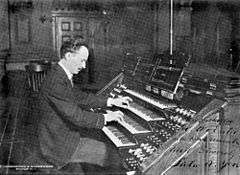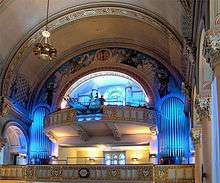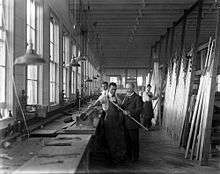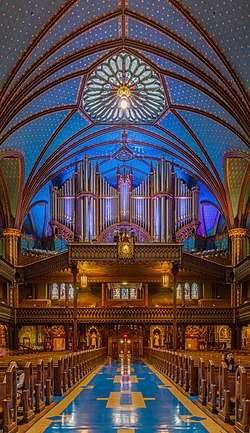Casavant Frères
| Private | |
| Industry | Pipe organ manufacturing |
| Founded | 1879 in Saint-Hyacinthe, Quebec |
| Founders | Joseph-Claver and Samuel-Marie Casavant |
| Headquarters | Saint-Hyacinthe, Quebec, Canada |
Areas served | Worldwide |
| Website |
www |


Casavant Frères is an organ building Canadian company in Saint-Hyacinthe, Quebec, which has been building pipe organs since 1879.[1] As of 2014, they have produced more than 3900 organs.[2]
Company history
Brothers Joseph-Claver (1855–1933) and Samuel-Marie (1859–1929) got their start in organ-building in the shop of their father Joseph Casavant under his successor Eusèbe Brodeur. Claver worked with Brodeur during 1874–1878, then went to France for a 14-month apprenticeship with the firm of John Abbey in Versailles.[3] He and Samuel then visited many organs and workshops in western Europe before establishing their factory on the site of their father's workshop on rue Girouard in Saint-Hyacinthe in 1879.[4][5]
Technical innovations
Their instruments boasted many innovations unique for that time, such as concave pedalboards, balanced expression pedals, keyboard improvements, and other enhancements. Their reputation as organ builders of international status was cemented in 1891 with their construction of the organ for the Notre-Dame de Montréal Basilica, a four-manual organ of eighty-two stops. This organ features adjustable combinations and speaking pipes of thirty-two foot length in the façade.[6]
They won the Grand Prix at the International Exhibition held in Antwerp, Belgium in 1930.
They built organs around the world, including Canada,[7] the United States, France, the West Indies, South and Central America, South Africa, and Japan. Their organs have been praised by many well-known organists over the last 100 years, including Guilmant, Vierne, Widor, caBonnet, Lemare, Dethier, Courboin, Bingham, and many others who inaugurated and played Casavant organs.
Casavant organs are also found in colleges, universities and conservatories in the United States and Canada.
After the death of the Casavant brothers, the company continued to add innovations to their instruments. These include a particularly reliable key contact and tracker touch mechanism, which is a feature of the Casavant playing action.
During the 1960s, Casavant developed new electronic technology to the capture system of combination actions.
In 1960, the company returned to mechanical action technology (while continuing to build electropneumatic action instruments as well) and has since built over two hundred tracker action instruments ranging in size from a single manual portable Continuo of four stops to two, three, and four manual organs.[8]
New technology, such as solid-state coupling and switching systems, multiplex, multi-memory combination actions and MIDI have been adopted. Other improvements, such as more effective expressive enclosures, continue to be made. The sound and style of Casavant organs has varied throughout the company's history. The Casavant brothers themselves, Samuel and Claver Casavant, reflected mostly influences from contemporary France, but they traveled widely and visited many European instruments. They later brought in an Englishman, Stephen Stoot, under whose direction the tonal palette reflected additional influences from England. Later tonal directors, Lawrence Phelps and Gerhard Brunzema, contributed styles from the German "Organ Reform Movement." The most recent tonal directors, Jean-Louis Coignet and Jacquelin Rochette, are rooted in but not limited to the various French organ building traditions.
Some significant Casavant organs

Montreal, Quebec

Montreal, Quebec

- Opus 34, 1892 (orig), Opus 715, 1917 (rebuilt), Opus 1647, 1940, Montreal, Quebec, Canada, Notre-Dame de Montréal Basilica, 83 stops,
- Opus 78, 1897, Westfield MA, St. Mary's Church, the oldest Casavant still in use in the United States, orig. Notre Dame Church, Pittsfield, MA, removed 2005, installed in St. Mary's 2008
- Opus 371, 1909; Opus 2071, 1951/2007, Edmonton, Alberta, Canada, First Presbyterian Church of Edmonton
- Opus 452, 1911 (orig), Opus 1841, 1946 (rebuilt), Sydney, NS, Highland Arts Theatre, 33 stops. 30 registers. 32 ranks. 2045 pipes.
- Opus 550, 1915, Toronto, Ontario, Canada, St Paul's Anglican Church, 106 stops
- Opus 553, 1915, Jacksonville, FL Jacksonville Symphony Orchestra 63 stops,
- Opus 600, 1915, Montreal, Quebec, Canada, Saint-Nom-de-Jésus, 90 stops
- Opus 700, 1917, Boston, MA, Emmanuel Episcopal Church, 137 stops, Relocation to an organ museum in Gulangyu Island, China in 2008
- Opus 715, 1917 - see Opus 34
- Opus 802, 1919, Ottawa, Ontario, Canada, The Ottawa Korean Community Church
- Opus 1200, 1927, Detroit, MI, The Detroit Institute of Arts Auditorium,
- Opus 1312, 1929, Toronto, Ontario, Canada, Royal York Hotel, 107 stops[5]
- Opus 1367, 1930, Toronto, Ontario, Canada, Metropolitan United Church, Five manuals, 109 stops[5]
- Opus 1397, 1930, Enfield, New Hampshire, United States, Mary Keane Chapel, Missionaries of Our Lady of La Salette, Three manuals. 4 divisions. 28 stops. 26 registers. 29 ranks. 1862 pipes.
- Opus 1424, 1932, Ottawa, Ontario, Canada, St. Joseph's Parish & Sanctuary. Three manuals, 1892 speaking pipes, and 24 stops.[9]
- Opus 1608, 1938, Montreal, Quebec, Canada, Saint James United Church, 64 stops, Rebuild of Wadsworth 1888 and Warren 1909.
- Opus 1647, 1940 - see Opus 75
- Opus 1659, 1940, Flushing, Long Island, New York, Saint Andrew Avellino Church (Roman Catholic) 43 stops,
- Opus 1841, 1917 - see Opus 452
- Opus 1879, 1921, Halifax, Nova Scotia, Canada, St. Matthew's United Church, 59 stops, 61 ranks. New console 1957. Revoiced and console digitized 1998
- Opus 1893/2560A, 1947/1959, Cambridge, Massachusetts, The Church of St. Paul (Harvard Square) (Roman Catholic) 50 stops, 1947
- Opus, 1925, War Memorial Pipe Organ in University of Alberta, Edmonton, Alberta Convocation Hall in memory of 80 University of Alberta comrades who gave up their lives during the Great War. The pipe organ was cleaned and reconditioned in 1947.[10]
- Opus 2025, 1950, Weston, Ontario, Canada, Central United Church
- Opus 2133, 1953, Saint John, New Brunswick, Canada, St. Peter's Church
- Opus 2269/2270, 1954/1955, St. John's, Newfoundland, Canada, Basilica of St. John the Baptist, 66 stops
- Opus 2570, 1960,[11] Halifax, Nova Scotia, Canada, St. Mary's Basilica, 38 stops, 2,856 pipes.[12]
- Opus 2576, 1960, Denver, CO, First Church Christ, Scientist, 69 ranks, 51 stops,
- Opus 2666, 1965, State College, PA, Grace Lutheran Church, 33 ranks and 2048 pipes,
- Opus 2670, 1963, Dayton, OH, Westminster Presbyterian Church.
- Opus 2722, 1963, Minneapolis, MN, Central Lutheran Church . 78 stops, 107 ranks

- Opus 2730, 1963, Wolfville, Nova Scotia, Acadia University, Canada, Manning Memorial Chapel
- Opus 2793, 1964, Fall River, Massachusetts, St. Anne's Church, 3 manuals. 4 divisions. 58 stops. 57 registers. 84 ranks. 4518 pipes
- Opus 2798, 1964, Montreal, Quebec, St. Antonin Church, 5391 Av Snowdown, 3 manuals. 33 stops. 51 ranks
- Opus 2839, 1965, Southgate, Michigan, Christ The King Lutheran Church
- Opus 2889, 1966, Traverse City, MI, First Congregational Church,
- Opus 2927, 1967, Saratoga Springs, NY, Bethesda Episcopal Church,
- Opus 2955, 1968, Fort Collins, CO, Colorado State University, Recital Hall, 2079 pipes, 34 stops
- Opus 3062, 1970, La Grange, IL, Emmanuel Episcopal Church,
- Opus 3079, 1970, Portland, OR, Chapel of Lewis & Clark College, 66-stops—probably the only organ in the world which was built entirely suspended from the ceiling.
- Opus 3101, 1971, Asheville, NC, Cathedral of All Souls in Biltmore Village
- Opus 3105, 1971, Iowa City, IA, University of Iowa, Iowa City, IA, USA, 53 stops, 74 ranks - hall now abandoned since 2008 due to flood damage. Organ to be relocated to St. Andrew's Presbyterian Church, Iowa City, IA [13]
- Opus 3145, 1972, Providence, Rhode Island, Cathedral of Saints Peter and Paul, 6,616 pipes, 125 ranks, 73 stops, largest mechanical action organ in North America[
- Opus 3254, 1975, Lansing, MI, Plymouth Congregation Church, 57 stops, 75 ranks
- Opus 3312, 1976, Guadalupe, Mexico, Basilica, 116 stops, 187 ranks
- Opus 3414, 1979, Scranton, PA, St. Peter's Cathedral
- Opus 3434, 1982, Melbourne, Australia, Hamer Hall (formerly Melbourne Concert Hall), Victoria Arts Centre, 60 stops, tracker action
- Opus 3700, 1993, Independence, MO, Temple complex of the Community of Christ, a four-manual organ of 60 stops, 5,685 pipes,
- Opus 3743, 1995, Lamoni, IA, Graceland University, 24 ranks
- Opus 3750, 1995/1996 Fort Worth, TX, Broadway Baptist Church, 191 ranks, 129 stops
- Opus 3796, 2001, Wheaton, IL Wheaton College, Edman Chapel
- Opus 3828, 2003, Dallas, TX, First United Methodist Church,
- Opus 3837, 2005, New York, NY, Brick Presbyterian Church (New York City), New York, NY,
- Opus 3839, 2004, Conover, NC, St. John's Lutheran Church,
- Miramichi, New Brunswick, Canada, St. James & St. John's United Church
- Opus 3899, 2012, Washington, DC, Rubenstein Family Organ, John F. Kennedy Center Concert Hall, Specification: [14]
- Opus 3900, 2014, Montréal, Quebec, Canada. Grand Orgue Pierre Béique at Maison Symphonique de Montréal.
Recordings
There have been many recordings performed on Casavant Frères organs.
Celebrated Canadian pianist Glenn Gould recorded his 1962 album The Art of the Fugue by Bach (Columbia Records) on a 1960 Casavant Frères organ in All Saints' Kingsway Anglican Church] in Toronto - available with other Art of Fugue recordings on Sony 87759. Destroyed by fire in 1966. A new Casavant organ, opus 3874 (2009) is now in the building.
External links
| Wikimedia Commons has media related to Casavant Frères. |
References
- ↑ Britishness Abroad: Transnational Movements and Imperial Cultures. Academic Monographs. 1 January 2007. p. 69. ISBN 978-0-522-85392-6.
- ↑ Pierre L. Delva and Joan Campbell-Delv (September 2013). The Biography of a New Canadian Family Volume 4. Xlibris Corporation. p. 182. ISBN 978-1-4797-7872-0.
- ↑ Elaine Keillor (18 March 2008). Music in Canada: Capturing Landscape and Diversity. McGill-Queen's Press - MQUP. p. 140. ISBN 978-0-7735-3391-2.
- ↑ Bouchard, Antoine. "Casavant Frères". Encyclopedia of Music in Canada. Retrieved 2008-12-19.
- 1 2 3 Industrial Canada. 31. Canadian Manufacturers' Association. 1930. p. 69.
- ↑ "Who needs Paris? Montreal is the new ‘City of Light’". Adam Bisby, Montreal, The Globe and Mail, April 30, 2018
- ↑ The Hymn. 63. Hymn Society of America. 2012. pp. 9–11.
- ↑ Forces. Issues 50-56. Société d'édition de la revue forces. 1980. p. 146.
- ↑ Where The Spirit Lives - A History of St. Joseph's Parish Ottawa, Ontario 1856-2006 - Terry V. Byrne 2007 ISBN 978-0-9782822-0-2
- ↑ University of Alberta War Memorial Pipe Organ, Convocation Hall
- ↑ Opus 2570, 1960
- ↑ Dedicated to St. Mary's Basilica parishioners who served in World War II
- ↑ "New city organ under restoration to be moved to St. Andrew". The Gazette, 2013/10/13
- ↑ William Littler; John Terauds (15 June 2013). Roy Thomson Hall: A Portrait. Dundurn. p. 53. ISBN 978-1-4597-1876-0.